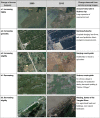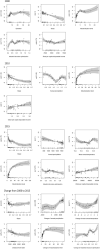Understanding the spatial-temporal variation of human footprint in Jiangsu Province, China, its anthropogenic and natural drivers and potential implications
- PMID: 32770004
- PMCID: PMC7414874
- DOI: 10.1038/s41598-020-70088-w
Understanding the spatial-temporal variation of human footprint in Jiangsu Province, China, its anthropogenic and natural drivers and potential implications
Abstract
Understanding the spatial and temporal patterns of human pressures provides a foundation for understanding interactions between human and environment and managing human activities for a sustainable development. This study is the first attempt focused within China at calculating the spatial-temporal human footprint and its driving forces in a highly urbanized area with intensive human activities. Population, land use, night-time lights, and road impacts were used to generate human footprint maps of Jiangsu Province for 2000, 2010 and 2015 with a resolution of 1 km * 1 km. Five natural drivers and four anthropogenic drivers were employed to construct generalized additive models for explaining the spatial variation of human footprint and its change. It shows that a large difference is between the human footprint in northern and southern Jiangsu, and the pattern of human pressures conforms to the "Matthew effect", with spatial aggregation of high human footprint areas accelerating. Slope, industrialization level are significant in explaining the spatial variation of human footprint in 2000, 2010 and 2015. The effect of natural drivers decreases for explaining the human footprint over time. Furthermore, annual precipitation, mean annual temperature and urban per capita disposable income are also significant drivers for human footprint in 2010 and 2015. And the increasing of human footprint slows with increasing of industrialization level. The difference of industrialization level and urban income between northern and southern Jiangsu mainly caused different driving pattern for human footprint and its change. Our study has generated new insights on the interaction pattern between human and nature in highly developed regions based on the human footprint concept, and can provide references for managing human activities in similar regions rapid socioeconomic development.
Conflict of interest statement
The authors declare no competing interests.
Figures





Similar articles
-
Evaluation and Prediction of the Ecological Footprint and Ecological Carrying Capacity for Yangtze River Urban Agglomeration Based on the Grey Model.Int J Environ Res Public Health. 2018 Nov 13;15(11):2543. doi: 10.3390/ijerph15112543. Int J Environ Res Public Health. 2018. PMID: 30428569 Free PMC article.
-
Impacts of Human Activities on Ecosystem Service Value in Arid and Semi-Arid Ecological Regions of China.Int J Environ Res Public Health. 2021 Oct 22;18(21):11121. doi: 10.3390/ijerph182111121. Int J Environ Res Public Health. 2021. PMID: 34769640 Free PMC article.
-
Identifying spatial agglomeration and driving forces of land use by green industries: a case study of Jiangsu Province, China.Environ Sci Pollut Res Int. 2023 Apr;30(19):54586-54599. doi: 10.1007/s11356-023-25740-z. Epub 2023 Mar 6. Environ Sci Pollut Res Int. 2023. PMID: 36877393
-
Assessment of rural ecosystem health and type classification in Jiangsu province, China.Sci Total Environ. 2018 Feb 15;615:1218-1228. doi: 10.1016/j.scitotenv.2017.09.312. Epub 2017 Oct 17. Sci Total Environ. 2018. PMID: 29751427
-
Coastal Landscape Vulnerability Analysis in Eastern China-Based on Land-Use Change in Jiangsu Province.Int J Environ Res Public Health. 2020 Mar 5;17(5):1702. doi: 10.3390/ijerph17051702. Int J Environ Res Public Health. 2020. PMID: 32150973 Free PMC article.
Cited by
-
Assessing the impact of human activities on ecosystem asset dynamics in the Yellow River Basin from 2001 to 2020.Sci Rep. 2024 Sep 27;14(1):22227. doi: 10.1038/s41598-024-73121-4. Sci Rep. 2024. PMID: 39333330 Free PMC article.
-
Spatiotemporally Comparative Analysis of HIV, Pulmonary Tuberculosis, HIV-Pulmonary Tuberculosis Coinfection in Jiangsu Province, China.Infect Drug Resist. 2023 Jun 23;16:4039-4052. doi: 10.2147/IDR.S412870. eCollection 2023. Infect Drug Resist. 2023. PMID: 37383602 Free PMC article.
References
-
- Vitousek PM, D'Antonio CM, Loope LL, Rejmanek M, Westbrooks RG. Introduced species: a significant component of human-caused global change. N. Z. J. Ecol. 1996;21:1–16.
-
- Halpern BS, et al. A global map of human impact on marine ecosystems. Science. 2008;319:948–952. - PubMed
-
- Rounsevell MDA, et al. Challenges for land system science. Land Use Pol. 2012;29:899–910.
MeSH terms
LinkOut - more resources
Full Text Sources

